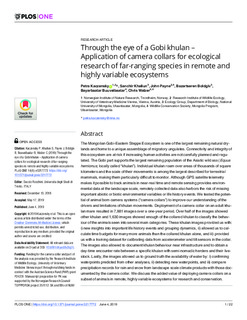| dc.contributor.author | Kaczensky, Petra | |
| dc.contributor.author | Khaliun, Sanchir | |
| dc.contributor.author | Payne, John | |
| dc.contributor.author | Boldgiv, Bazartseren | |
| dc.contributor.author | Buuveibaatar, Bayarbaatar | |
| dc.contributor.author | Walzer, Chris | |
| dc.date.accessioned | 2019-06-12T13:39:34Z | |
| dc.date.available | 2019-06-12T13:39:34Z | |
| dc.date.issued | 2019 | |
| dc.identifier.uri | http://hdl.handle.net/11250/2600654 | |
| dc.description.abstract | The Mongolian Gobi-Eastern Steppe Ecosystem is one of the largest remaining natural drylands
and home to a unique assemblage of migratory ungulates. Connectivity and integrity of
this ecosystem are at risk if increasing human activities are not carefully planned and regulated.
The Gobi part supports the largest remaining population of the Asiatic wild ass (Equus
hemionus; locally called “khulan”). Individual khulan roam over areas of thousands of square
kilometers and the scale of their movements is among the largest described for terrestrial
mammals, making them particularly difficult to monitor. Although GPS satellite telemetry
makes it possible to track animals in near-real time and remote sensing provides environmental
data at the landscape scale, remotely collected data also harbors the risk of missing
important abiotic or biotic environmental variables or life history events. We tested the potential
of animal born camera systems (“camera collars”) to improve our understanding of the
drivers and limitations of khulan movements. Deployment of a camera collar on an adult khulan
mare resulted in 7,881 images over a one-year period. Over half of the images showed
other khulan and 1,630 images showed enough of the collared khulan to classify the behaviour
of the animals seen into several main categories. These khulan images provided us with:
i) new insights into important life history events and grouping dynamics, ii) allowed us to calculate
time budgets for many more animals than the collared khulan alone, and iii) provided
us with a training dataset for calibrating data from accelerometer and tilt sensors in the collar.
The images also allowed to document khulan behaviour near infrastructure and to obtain a
day-time encounter rate between a specific khulan with semi-nomadic herders and their livestock.
Lastly, the images allowed us to ground truth the availability of water by: i) confirming
waterpoints predicted from other analyses, ii) detecting new waterpoints, and iii) compare
precipitation records for rain and snow from landscape scale climate products with those documented
by the camera collar. We discuss the added value of deploying camera collars on a
subset of animals in remote, highly variable ecosystems for research and conservation. | nb_NO |
| dc.language.iso | eng | nb_NO |
| dc.rights | Navngivelse 4.0 Internasjonal | * |
| dc.rights.uri | http://creativecommons.org/licenses/by/4.0/deed.no | * |
| dc.title | Through the eye of a Gobi khulan – Application of camera collars for ecological research of far-ranging species in remote and highly variable ecosystems | nb_NO |
| dc.type | Peer reviewed | nb_NO |
| dc.type | Journal article | |
| dc.rights.holder | © 2019 Kaczensky et al. | nb_NO |
| dc.subject.nsi | VDP::Matematikk og Naturvitenskap: 400::Zoologiske og botaniske fag: 480 | nb_NO |
| dc.source.journal | PLoS ONE | nb_NO |

